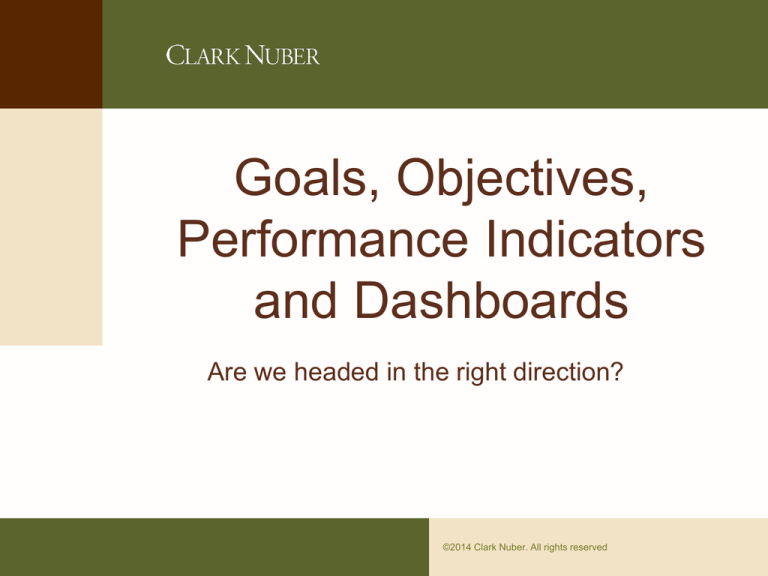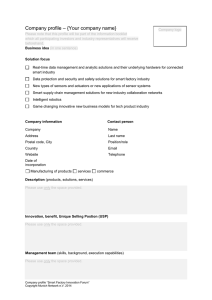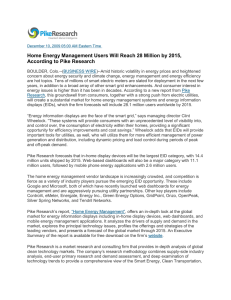
Goals, Objectives,
Performance Indicators
and Dashboards
Are we headed in the right direction?
©2014 Clark Nuber. All rights reserved
Page 0
Enterprise Level Goals
• Important, but not part of this talk –
–
–
–
–
Aspirational goals
Vision
Mission
Strategic Goals
Page 1
Vision and Goals
• A vision without goals is lame, and
• Goals without a vision are ineffective at
motivating the team
Page 2
Goals and Objectives:
Where are we going?
Enterprise Level
Goals
Mid-level
Organizational Goals
Shop Floor Goals
Page 3
Enterprise Level Goals
• Answer the question: How will we
know when we are winning?
• S.M.A.R.T. Goals
• S.trategic
• M.easurable
• A.ttainable
• R.ealistic
• T.ime-sensitive
Page 4
SMART Goal Examples
• Enterprise Level
– Optimize the spread between sales and
costs per paid hour
– Increase sales per employee by 7%
– 5% increase in ROI annually
– EBITDA in top 10% of industry annually
– 10% of sales coming from new products
every year
Page 5
Smart Goal Example
FY 11
FY 11 –
mid yr.
FY 10
FY 10
mid yr.
FY 09
FY 09
mid yr.
FY 08
FY08mid yr.
• Financial Perspective
The Spread – sales/hr., Costs/hr.
Annual Trend
Page 6
SMART Goal Example
14,000,000
26.0%
EBITDA & EBITDA% of Net Sales (TTM)
24.0%
12,000,000
22.0%
10,000,000
20.0%
3,000,000
18.0%
16.0%
6,000,000
14.0%
4,000,000
12.0%
10.0%
Page 7
SMART Goal Example
17,300
Net Sales/FTE (TTM)
17,250
17,200
17,150
17,200
17,050
17,000
16,250
26,300
16,150
Page 8
SMART Goal Examples
• Mid-Level Department Goals
– Improve on-time deliveries by10% over last year
– Improve Cash-to Cash cycle by 15 days over last
year’s monthly average
– Achieve 30% gross profit per order
– Decrease indirect time as a percentage of total
by 5% over prior year
– Increase hours earned by 6% over prior month
average
– Improve inventory turnover rates by .5 times on
annual basis
Page 9
SMART Goal Examples
Aug 11
Jul 11
Jun 11
May 11
Apr 11
Mar 11
Feb 11
Jan 11
Dec 10
Nov 10
Oct 10
Sep 10
190
170
150
130
110
90
70
50
Aug 10
Internal Process Perspective
Cash to cash cycle
Page 10
SMART Goal Examples
50
4.5
Inventory Turnover Rate
4.0
3.5
3.0
2.5
2.0
Page 11
SMART Goal Examples
25,000,000
Gross Profit Margin & Gross Profit Margin % (TTM)
45.0%
24,000,000
40.0%
23,000,000
35.0%
22,000,000
30.0%
21,000,000
25.0%
20,000,000
19,000,000
20.0%
18,000,000
15.0%
17,000,000
10.0%
Page 12
SMART Goal Examples
• Shop Floor Goals
– Reduce re-work to 1% of direct hours
– Maintain on-time delivery at 98%
– Reduce cycle time by 7% over last month’s
average
– Achieve actual hours/standard hours at +/- 3%
– Maintain average turnaround time at 12 days
– Reduce work-order backlog to less than 20 per
day average
– All customer quotes delivered within 48 hours
Page 13
SMART Goal Examples
Page 14
Goals Translated to Key
Performance Indicators
•
•
•
•
Alignment from top to bottom
A measurement of performance
Measured against a standard or goal
Is it really a KEY performance indicator?
–
–
–
–
–
Something you cannot ignore
Tracking KPIs will come at a cost – Don’t overdo it!
Pertinent to the user – can user do something about it?
Operational, tactical, strategic
High level, visual interactive, intuitive, alert to need for action
Page 15
Building Dashboards –
What’s the Process?
• Form a diverse team of interested executives
• Define the project goals and desired outcomes
• Start with Key Performance Indicators (KPIs)
– Enterprise
– Department
– Shop floor
• Think top to bottom alignment
• Identify data sources and possible gaps in data
• Select appropriate dashboard tools
Page 16
Building Dashboards –
What’s the Process?
• Communicate plans and intended use of the
Dashboards
• Anticipate resistance
• Perform system integrity and user acceptance testing
• Monitor use, solicit feedback, improve (continuous
process)
• Add, delete, change KPIs as needed. (you should
expect this to occur)
Page 17
Building Dashboards –
What’s the Process?
•
•
•
•
Audit the data to ensure accuracy
Evaluate usage
Caution – don’t try to do too much too fast
Evaluate results – are dashboards driving the desired
behavior?
Page 18
Top Tips for Success in
Dashboard Design
• Design your layout based on how you
view your data
• Create a mock up/proof of concept
• Design with the end user in mind
• Create a layout that scales
• Don’t create a visual that is “too busy”
• Use summarized data
• Find a good software solution
Page 19
Page 20







